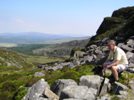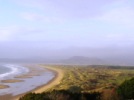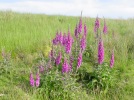Trees Birds Mammals Fish Amphibians Reptiles
Wild Algarve
Bookshop
Guide to the Nature Reserves and other top Wildlife Sites in Wales
Wales has more nature reserves per head of population than any other major European country. There are five Areas of Outstanding Natural Beauty, three National Parks, 74 National Nature Reserves and hundreds more Local Nature Reserves, Wildlife Trust and RSPB Reserves etc each protecting unique habitats and the wildlife that depend on them.
Tables of Reserves pages can be arranged in the order that best suits your needs.
Reserve
Name |
Region of
Wales |
County |
Nearest
Town |
Primary
Feature |
Other
Features |
| Aberbargoed Grasslands |
East |
Caerphilly |
Bargoed |
Insects |
Plants |
| Allt Rhyd y Groes |
Southwest |
Carmarthenshire |
Llandovery |
Plants |
Birds |
| Allt y Benglog |
North |
Gwynedd |
Dolgellau |
Plants |
Birds |
| Anglesey Fens |
North |
Anglesey |
Pentraeth |
Plants |
Birds, Insects |
| Bardsey Island |
North |
Gwynedd |
Aberdaron |
Birds |
Plants, Lichens |
| Berwyn/Y Berwyn |
East |
Powys |
Bala |
Birds |
Plants, Lichens |
| Cadair Idris |
North |
Gwynedd |
Dolgellau |
Geology |
Plants |
| Carmel Woods |
Southwest |
Carmarthenshire |
Llandeilo |
Plants |
Bats, Birds, Insects |
| Ceunant Cynfal |
North |
Gwynedd |
Llan Ffestiniog |
Bats |
Trees, Lichens, Mosses, Ferns, Birds |
| Ceunant Llennyrch |
North |
Gwynedd |
Gellilydan |
Bats |
Trees, Lichens, Mosses, Ferns, Birds |
| Claerwen |
East |
Powys |
Rhyader |
Birds |
Plants, Lichens |
| Coed Cymerau |
North |
Gwynedd |
Blaenau Ffestiniog |
Bats |
Trees, Lichens, Mosses, Ferns, Birds |
| Coed Dalgarrog |
North |
Conwy |
Llanrwst |
Plants |
Birds, Fungi, Insects |
| Coed Ganllwyd |
North |
Gwynedd |
Maentwrog |
Bats |
Trees, Lichens, Mosses, Ferns, Birds |
| Coed Gorswen |
North |
Conwy |
Conwy |
Plants |
Insects, Birds |
| Coed Llyn Mair |
North |
Gwynedd |
Maentwrog |
Bats |
Trees, Lichens, Mosses, Ferns, Birds |
| Coed Rheidol |
Southwest |
Ceredigion |
Aberystwyth |
Plants |
Birds, Fungi |
| Coed Tremadog |
North |
Gwynedd |
Tremadog |
Bats |
Trees, Lichens, Mosses, Ferns, Birds |
| Coed y Cerrig |
East |
Monmouthshire |
Abergavenny |
Plants |
Birds, Insects |
| Coed y Rhygen |
North |
Gwynedd |
Trawsfynydd |
Bats |
Trees, Lichens, Mosses, Ferns, Birds |
| Coedmor |
Southwest |
Ceredigion |
Cardigan |
Lichens |
Plants, Birds |
| Coedydd Aber |
North |
Gwynedd |
Bangor |
Plants |
Geology, Birds, Fungi |
| Cors Bodelio |
North |
Anglesey |
Pentreath |
Plants |
Insects, Birds |
| Cors Caron |
Southwest |
Ceredigion |
Tregaron |
Birds |
Insects, Plants |
| Cors Erddreiniog |
North |
Anglesey |
Benllech |
Plants |
Insects, Birds |
| Cors Geirch |
North |
Gwynedd |
Nefyn |
Plants |
Insects |
| Cors Goch Llanllwch |
Southwest |
Carmarthenshire |
Carmarthen |
Plants |
Insects, Birds |
| Cors Goch |
North |
Anglesey |
Pentraeth |
Plants |
Insects, Birds |
| Cors Gyfelog |
North |
Gwynedd |
Caernarfon |
Plants |
Insects |
| Cors y Llyn |
East |
Powys |
Newbridge on Wye |
Plants |
Insects, Birds |
| Craig Cerrig Glesisiad a Fan Frynych |
East |
Powys |
Brecon |
Plants |
Lichens, Mosses, Birds, Geology |
| Craig y Cilau |
East |
Powys |
Crickhowell |
Bats |
Plants, Insects, Geology |
| Crymlyn Bog and Pant y Sais |
Southwest |
Swansea |
Swansea |
Plants |
Insects, Birds |
| Cwm Cadlan |
East |
Rhondda Cynon Taff |
Hirwaun |
Plants |
Geology |
| Cwm Clydach |
East |
Monmouthshire |
Brynmawr |
Plants |
Fungi, Birds |
| Cwm Glas Crafnant |
North |
Conwy |
Betws y Coed |
Plants |
Geology |
| Cwm Idwal |
North |
Gwynedd |
Bethesda |
Geology |
Plants |
| Dan yr Ogof |
East |
Powys |
Ystradgynlais |
Geology |
|
| Dinefwr |
Southwest |
Carmarthenshire |
Llandeilo |
Fungi |
Insects, Birds |
| Dyfi |
Southwest |
Ceredigion |
Borth |
Plants |
Birds, Insects |
| Fenn's Whixhall & Bettisfield Mosses |
North |
Wrexham and Shropshire |
Whitchurch |
Birds |
Insects, Animals |
| Fiddlers Elbow |
East |
Monmouthshire |
Monmouth |
Plants |
Animals |
| Gower Coast |
Southwest |
Swansea |
Swansea |
Geology |
Birds, Plants |
| Grassholm Island |
Southwest |
Pembrokeshire |
Haverfordwest |
Birds |
Whales, Dolphins, Seals |
| Great Orme/Maes y Facrell - Pen y Gogarth |
North |
Conwy |
Llandudno |
Plants |
Birds, Insects |
| Gregynog |
East |
Powys |
Newtown |
Lichen |
Birds, Bats, Fungi, Insects, Plants |
| Hafod Elwy |
North |
Denbighshire |
Betws y Coed |
Birds |
Plants |
| Hafod Garregog |
North |
Gwynedd |
Porthmadog |
Plants |
Birds |
| Kenfig Pool and Dunes |
East |
Bridgend |
Kenfig |
Plants |
Birds, Insects, Fungi |
| Lady Park Wood |
East |
Monmouthshire |
Monmouth |
Plants |
Bats |
| Llangloffan Fen |
Southwest |
Pembrokeshire |
Fishguard |
Birds |
Insects, Plants |
| Llyn Eiddwen |
Southwest |
Ceredigion |
Aberaeron |
Plants |
Birds, Insects |
| Meirionydd Oak Woodlands |
North |
Gwynedd |
Porthmadog |
Bats |
Trees, Lichens, Mosses, Ferns, Birds |
| Merthyr Mawr |
East |
Bridgend |
Bridgend |
Plants |
Fungi, Insects |
| Morfa Dyffryn |
North |
Gwynedd |
Barmouth |
Plants |
Birds, Insects |
| Morfa Harlech |
North |
Gwynedd |
Harlech |
Plants |
Birds, Insects |
| Nant Irfon |
East |
Powys |
Llanwrtyd Wells |
Plants |
Birds |
| Newborough Warren |
North |
Anglesey |
Newborough |
Plants |
Insects, Fungi, Mammals |
| Newport Wetlands |
East |
Newport |
Newport, Gwent |
Birds |
Insects, Plants |
| Ogof Ffynnon Ddu |
East |
Powys |
Ystradgynlais |
Geology |
Plants, Birds |
| Oxwich |
Southwest |
Gower |
Swansea |
Plants |
Insects, Birds |
| Pengelli Forest |
Southwest |
Pembrokeshire |
Cardigan |
Birds |
Bats, Plants, Insects |
| Penhow Woodlands |
East |
Newport |
Newport |
Plants |
Birds, Insects |
| Ramsey Island |
Southwest |
Pembrokeshire |
St. David's |
Birds |
|
| Rhinog |
North |
Gwynedd |
Dolgellau |
Birds |
Plants |
| Rhos Goch |
East |
Powys |
Builth Wells |
Plants |
Insects |
| Rhos Llawr Cwrt |
Southwest |
Ceredigion |
New Quay |
Insects |
Plants |
| Roundton Hill |
East |
Powys |
Newtown |
Plants |
Fungi |
| Skomer |
Southwest |
Pembrokeshire |
Haverfordwest |
Birds |
Mammals, Plants |
| Snowdon/Yr Wyddfa |
North |
Gwynedd |
Llanberis |
Plants |
Geology, Birds |
| Stackpole |
Southwest |
Pembrokeshire |
Pembroke |
Bats |
Birds, Plants |
| Stanner Rocks |
East |
Powys |
Kington |
Plants |
Geology |
| Ty Canol |
Southwest |
Pembrokeshire |
Fishguard |
Lichens |
Fungi, Birds |
| Waun Las |
Southwest |
Carmarthenshire |
Carmarthen |
Fungi |
Plants |
| Whiteford |
Southwest |
Gower |
Gowerton |
Plants |
Birds, Insects |
Reserve
Name |
Region of
Wales |
County |
Nearest
Town |
Primary
Feature |
Other
Features |
| Abercorris NWWT Nature Reserve |
North |
Gwynedd |
Machynlleth |
Plants |
Birds, Mammals |
| Afon Lleiniog LNR |
North |
Anglesey |
Llangoed |
Plants |
Bats, Birds |
| All Wales Coast Path |
All |
All coastal |
All coastal |
All |
All |
| Bryn Pydew NWWT |
North |
Conwy |
Llandudno |
Plants |
Insects |
| Cae Blaen Dyffryn Plantlife Reserve |
Southwest |
Carmarthenshire |
Lampeter |
Plants |
Insects |
| Cemlyn Bay NWWT |
North |
Anglesey |
Cemlyn |
Birds |
Plants, Insects, Marine |
| Cors Dyfi MWT Reserve |
East |
Powys |
Machynlleth |
Birds |
Insects, Plants |
| Glaslyn Ospreys |
North |
Gwynedd |
Porthmadog |
Birds |
|
| Goodwick Moor WTSWW |
Southwest |
Pembrokeshire |
Fishguard |
Birds |
Plants, Insects |
| Llangloffan Fen WTSWW |
Southwest |
Pembrokeshire |
Fishguard |
Plants |
Insects, Birds |
| Llyn Crafnant Circuit (Walk) - Forestry Commission |
North |
Gwynedd |
Betws y Coed |
Plants |
Woodland, Scenery |
| Mariandyrys LNR |
North |
Anglesey |
Llangoed |
Plants |
Birds, Insects, Fungi |
| Minera Quarry NWWT |
North |
Wrexham |
Minera |
Plants |
Insects, Bats |
| Nant Porth NWWT Reserve |
North |
Gwynedd |
Bangor |
Plants |
Trees, Birds |
| Priory Grove Woods, Woodland Trust |
East |
Monmouthshire |
Monmouth |
Plants |
Birds, Animals |
| Secret Marsh, Pembrokeshire National Park Nature Reserve |
Southwest |
Pembrokeshire |
Tenby |
Birds |
Plants, Insects |
| Spinnies Aberogwen |
North |
Gwynedd |
Bangor |
Birds |
Plants |
| Teifi Marshes WTSWW |
Southwest |
Pembrokeshire |
Cardigan |
Birds |
Plants, Mammals |
| Wildfowl and Wetlands Centre |
Southwest |
Carmarthenshire |
Llanelli |
Birds |
Plants, Insects |
What you will find on this Website

Thinking of North Wales conjours up images of mountains and the dramatic scenery that accompanies them: the rushing rivers, valleys, moorlands and mires that lie within and between the ranges of Snowdonia, the Clwydians and the gentler Berwyns.
But let's not forget the lovely coastline with its fabulous sandy beaches and dune systems; and, set back from the coast, the fens, raised bogs, woodlands and limestone pavements. Each of these unique habitats is a support system for numerous plants, insects and animals.

Southwest Wales, equally well known as a holiday destination by the thousands of people who flock there each year, also has a hidden side: the lovely rivers protected in their own right because of the precious wildlife that lives in them, the beautiful bluebell woods that are also home to many rare and interesting fungi species in the autumn, the ancient meadows that support numerous wild orchids and other unusual plants, and the inshore islands that are home to internationally important colonies of nesting sea birds and many other unique wildlife species.

East Wales, perhaps less known as a holiday destination, still has more than its fair share of interesting places to see wildlife in habitats that are threatened or endangered in many other parts of Britain. Here you will find the Montgomery Canal, the Brecon Beacons and the Wye Valley. Kenfig - it also has one of Wales's best known coastal nature reserves - is home to numerous wild orchids including the rare Fen Orchid. This area also contains an increasingly rare habitat, unimproved lowland acid grassland - a good example of this is Roundton Hill National Nature Reserve - and there is a management programme running in East Wales to restore some of the numerous fragments of this precious environment to good ecological state. The terrain is characterised by thin soils lying on rock which are home to special plants referred to as 'spring ephemerals' - plants that germinate, grow, flower and set seed in the space of around eight weeks or until the soils dry out in the increasing heat of early summer.
This website is a guide to these special places. It provides not only detailed descriptions of the wildlife of Wales's protected habitat, but also location maps and clear directions for finding each nature reserve plus details of facilities and the accessibility, or otherwise, of the terrain at each site.
Finding your way around the Nature Reserves of Wales
The nature reserves are listed on a main index page (this page), and in dropdown menus accessible from every nature reserve page, enabling you to move quickly from one site to another. The index table of NNRs can be sorted in four ways: alphabetically by reserve name, by region and county, by nearest town, and by species interest - birds, bats, wildflowers, fungi, butterflies and so on. There are regional maps for North, Southwest and East Wales showing the location of the reserves, with links from each map point to the relevant dedicated reserve page.
For those interested in the conservation designations of the wild places of Wales there is a page listing the conservation designations accorded to the sites in Wales together with a description of what each designation - Special Area of Conservation (SAC), Special Protection Area (SPA), Site of Special Scientific Interest (SSSI), Ramsar Site etc - means in terms of its national, European or international importance.